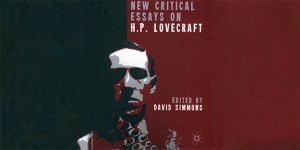 The content of the introduction to this new scholarly tome of Lovecraftian criticism should be familiar to all who attended the 2013 NecronomiCon as the author, S.T. Joshi, used much of this material in his opening address held at the First Baptist Church in Providence. In the forward, Joshi describes the singular rise of Providence author H.P. Lovecraft’s literary reputation from nearly forgotten 1930s pulp writer to a secure place in America’s literary pantheon, alongside such luminaries as Poe and Hawthorne.
The content of the introduction to this new scholarly tome of Lovecraftian criticism should be familiar to all who attended the 2013 NecronomiCon as the author, S.T. Joshi, used much of this material in his opening address held at the First Baptist Church in Providence. In the forward, Joshi describes the singular rise of Providence author H.P. Lovecraft’s literary reputation from nearly forgotten 1930s pulp writer to a secure place in America’s literary pantheon, alongside such luminaries as Poe and Hawthorne.
With Lovecraft’s reputation secure, says Joshi, all that is left is “the continued evaluation of his entire work… And the placing of that work in the context of [Lovecraft’s] times and in the overall history of weird and mainstream literature.” New Critical Essays On H. P. Lovecraft is an important, erudite, yet readable collection of essays that might be seen as the beginning of Joshi’s call for a new era of such scholarship.
Published by Palgrave Macmillan at a list price of $85, this is not a book for the casual Lovecraft reader, but a book aimed at hard core fans and college libraries. The seriousness with which the subject is approached does not mean that the book lacks a sense of fun. An entire chapter is dedicated to Lovecraft’s influence on comics (with ample illustrations) and another chapter explores Lovecraft’s influence on “extreme” heavy metal music.
As is often the case with scholarly work, the various authors sometimes delve into literary minutia to make their cases. The second and third chapters focus on Lovecraft’s short story “Dreams in the Witch House,” which has never been considered one of the writer’s stronger entries and was once referred to as “Lovecraft’s magnificent failure” by critic Steven Mariconda. Still, this story features one of Lovecraft’s strongest woman characters, even if she is an ugly, evil, dimension-hopping witch. This focus on odd characters in obscure stories is necessary because many critics want to engage with Lovecraft’s depiction of women, such as it is. As it stands, Lovecraft has written very little about women, and almost nothing about sexual relations, unless one is willing to read between the lines.
The strength of the first three chapters is that they do not turn a blind eye toward or try to explain away Lovecraft’s overt racism and (presumably unconscious) misogyny. Instead, the essays explore the ways Lovecraft’s attitudes flavored and informed his brand of weird fiction, which stressed the horrors of otherness, miscegenation, race and sex. Chapter four deals with Lovecraft’s relationship with modernism, while chapters five and six deal with aspects of two of Lovecraft’s most famous stories, “At the Mountains of Madness” and “The Dunwich Horror.”
The first half of the book concerns itself with Lovecraft and his fiction, but the last six chapters deal with Lovecraft’s place in modern pop culture. Here the book really shines in my opinion. Chapter seven details the ways in which Lovecraft’s work was interpreted and warped by August Derleth, the man who, along with Donald Wandrei, kept Lovecraft’s work in print until his literary worth was secured, but not without Derleth’s rather odd reinterpretation of Lovecraft’s ideas. Chapter eight talks about Lovecraft’s literary ascension, and his inclusion in the Library of America.
My favorite chapter, nine, was titled “Co(s)mic Horror,” and was a fairly complete introduction to the exploration of Lovecraft’s influence on comics and a history of the comic adaptations his work inspired. There is an irony in Lovecraft being adapted into comics (or movies for that matter) since much of what Lovecraft wrote about he described as being “indescribable.” This presents a challenge to artists eager to interpret his work.
Chapter ten covered Lovecraft’s influence on heavy metal music, while chapter eleven compared Lovecraft with the weird fiction author China Miéville, who admits Lovecraft as an influence on his work. The final chapter could almost have worked better as the first chapter, since it attempts to be a summary of Lovecraft’s impact on popular culture covering everything from literature, movies, comics and role playing games.
This anthology works as a photograph of the current state of Lovecraftian scholarship, outlining in broad strokes many different directions of inquiry. The work is of course not complete – there is plenty of scholarly work yet to be done.
Lovecraft was once “owned” by his fans, who kept his work and legacy alive when no one took him seriously. Now that academia is becoming interested, fans will find that they will have to share their favorite author with scholars. Far from being put off by this, interested fans should find their experience of Lovecraft’s work enhanced and enriched.